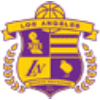We have reached the dog days of the summer, with the draft done, free agency fizzled, and Summer League saying sayonara. Even the Russell Westbrook situation is resolved, with the guard renegotiating and extending his contract with the Oklahoma City Thunder.
It’s a rare sleepy period for the NBA world (aside from the Olympics), and with nearly all of the pieces firmly in place, it’s the perfect time to examine exactly what GM Mitch Kupchak has put together for new coach Luke Walton to work with.
While we can’t know for certain what Walton’s rotation will look like at this early stage, here is an educated guess at what the Lakers’ depth chart currently looks like:
PG: D’Angelo Russell/Jose Calderon/Marcelo Huertas
SG: Jordan Clarkson/Lou Williams
SF: Luol Deng/Brandon Ingram/Anthony Brown/Nick Young*
PF: Julius Randle/Larry Nance Jr.
C: Timofey Mozgov/Tarik Black/Ivica Zubac
*Likely to not be on the team next season, but as of now, he is still under contract.
It’s certainly an interesting mix. First and foremost, it’s very apparent that the Lakers went into free agency dead set on adding high-character veterans. With an average age of just over 23 after the draft (including Young), it was clear that the team needed seasoned players to replace the departing Kobe Bryant, Roy Hibbert, and Brandon Bass.

It’s a sensible goal. Los Angeles has a young, inexperienced coach in Walton and a litter of pups to develop. Russell, Clarkson, Ingram, Brown, Randle, Nance, Black, and Zubac provide hope for a brighter future, but handling that many youngsters would be a challenge even for an experienced coach. The Lakers didn’t hire Walton to set him up for failure, even if “success” and “winning” are not one in the same at this point.
Moreover, player development doesn’t happen by accident. You can’t just throw a bunch of young players on the court, add a basketball, and then sit back and watch superstars sprout. Veteran leadership is needed to set an example and develop a culture, which ultimately will lead to faster development and better basketball.
We see this concept being applied in Minnesota, where veterans like Tayshaun Prince and Kevin Garnett were added to illuminate the path forward for Karl-Anthony Towns, Zach LaVine, and Andrew Wiggins. Even the Philadelphia 76ers, as trusting as they are (were?) in the process, added Elton Brand mid-season after rookie Jahlil Okafor was involved in several off-court incidents. Sometimes guidance is more impactful when it comes from a peer rather than a coach.
For the Lakers, the answer to the veteran conundrum came in the form of free agents Deng (31), Huertas (33), and Mozgov (30), as well as the trade for Calderon (34). They, along with Williams (30 in October), will be judged not only on their ability to perform on the court, but also on how they help the young Lakers develop.
There is no longer any question, Los Angeles is going all-in on the next generation.

Still, as clear as the goal may be, the Lakers roster appears to be sharply divided into two distinct camps. On one end of the spectrum, the young players range from 18-24, while the veterans range from almost 30 to 34. That’s a minimum of a six-year age gap between the two groups, which could make Walton’s efforts to foster communication difficult.
Compounding the issue, there are precisely zero players on the Lakers roster who are in the prime of their careers, which typically occurs between 26-28 years of age. In fact, only Black (25 in November) is anywhere close to the sweet spot, which means play on the court may not be pretty, especially in the early days of the season.
The 2016-2017 Lakers are a team that is built with the purpose of developing the future, but given the mistakes typically made by young players and the declining athleticism of the long-toothed vets, they aren’t set up to win a lot of games next year. That could make things interesting in regards to post-Kobe TV ratings and the infamous Jim Buss deadline, but those pressures aside, Walton explained last month that his expectations for the team will wisely not revolve around wins and losses.
Impressively, Kupchak has managed to give Walton a roster with young talent at every position as well as veterans to act as training wheels, in theory creating a team that can grow together organically for years to come. The same can’t be said for the 76ers, whose rebuild has brought them a glut of forwards and centers with talent but no possibility of them growing alongside each other. Everyone, including the players themselves, know that sooner or later, they will be split up via trade.
It’s a stark contrast, and the Lakers have to be hoping that the stability their well-rounded team offers will aid in their long-term development, even if wins aren’t plentiful in the here-and-now.
It’s not a perfect roster by any means, and some of the contracts handed out this summer are more than questionable, but at the very least, the Lakers have finally handed the keys to the young players and installed a support system to help them on their way.
Walton has everything he needs to develop the Lakers’ bright future. It won’t happen overnight, but it should be entertaining to watch. Winning is fun, but building something can be a rewarding process too.




